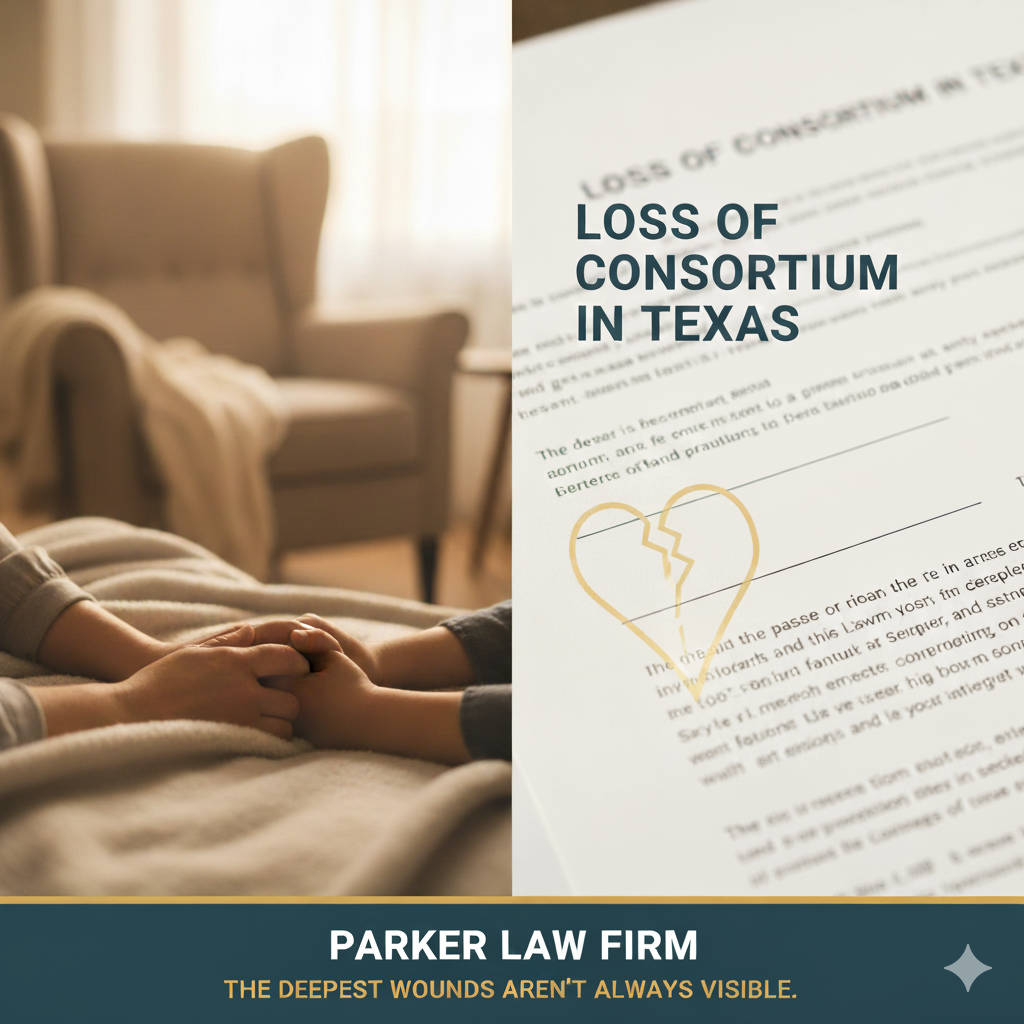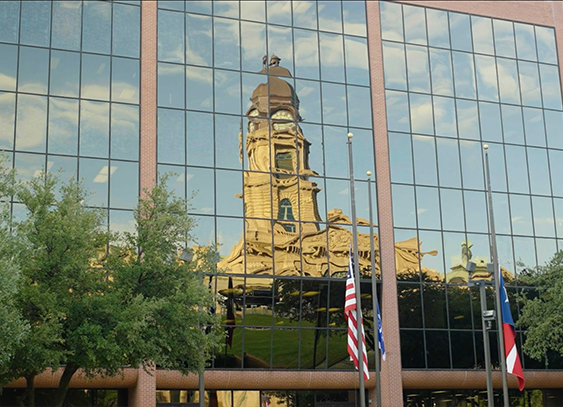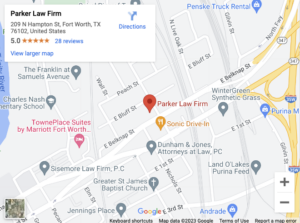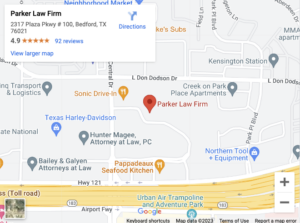Loss of Consortium in Texas: A Comprehensive Guide

When a serious accident happens, everyone focuses on the obvious injuries. Broken bones, hospital stays, and physical therapy are what people see. But for the family, the hardest part is often what no one else notices. The house feels empty. The routines are gone. The person you relied on is missing, and life just isn’t the same. This kind of loss doesn’t leave a visible scar, but it changes everything.
This invisible wound is not just an emotional hardship; it is a recognized loss in the eyes of Texas law. The fight to achieve recognition of this profound personal devastation is considered a loss of consortium claim. It is not just a legal term. It is the path to validation and the process of making an invisible injury visible, to a judge and jury, thus ensuring that the full scope of a family’s loss is seen, valued, and compensated. The deepest wounds aren’t always visible, but they deserve to be seen. At Parker Law Firm, we don’t see you as a secondary part of a lawsuit; we see you as a family whose story must be told. We are here to help you tell that story and fight for the full value of what was taken from you.
What Is a Loss of Consortium Claim in Texas?
A loss of consortium claim in Texas is a way for close family members to get compensation when someone’s negligence seriously injures or kills a loved one. It’s not about medical bills or lost paychecks. It’s about the loss of companionship, support, and love—the things that make a family whole. The law recognizes that these losses are real and matter just as much as any physical injury.
It is important to understand that a loss of consortium claim in Texas is what is known as a “derivative” claim. This simply means that it is directly tied to the primary personal injury or wrongful death lawsuit. For the loss of consortium claim to be successful, the case of the injured or deceased family member must first be proven successful. If the primary claim is not won, the derivative claim cannot stand on its own. This legal link underscores a fundamental truth: the suffering of the family is a direct and foreseeable consequence of the wrongful act that harmed their loved one. It is not a separate tragedy but an echo of the initial one, an echo reverberating through the heart of the family.
Who Can File for Loss of Consortium in Texas? The Strict Rules of Eligibility
Knowing who can file a loss of consortium claim is the first step. Texas law is strict about this and only allows the closest family members to bring these claims. We know this can be tough to hear, especially for those who don’t fit into these categories. From the start, we’re upfront and honest about what the law allows, so you know exactly where you stand.
In Texas, only three types of relationships are acceptable to file a loss of consortium claim. First, a spouse can file a claim for the loss of their partner’s companionship, affection, and services, whether the injury was non-fatal or resulted in a wrongful death. The most widely understood form of a spouse loss of consortium claim in acknowledges the profound and unique bond of a marriage. Second, a child, whether an adult or minor, this is only permissible if the parent suffered a “serious, permanent, and disabling” injury or died. The law sets this high standard because it seeks to compensate the child for the irreplaceable loss of a parent’s love, guidance, and support. This loss occurs in the wake of a truly catastrophic event. Finally, a parent can file for loss of consortium, but only in the devastating circumstance of the death of their child. Texas law does not permit a parent to recover these damages if their child survives an injury, no matter how severe.
Can Siblings or Unmarried Partners File for Loss of Consortium in Texas?
We often hear this question, and delivering the answer is one of the most challenging parts of our job. Under current Texas law, siblings cannot file for loss of consortium. We have seen firsthand the heartbreaking reality of this rule, especially in cases involving twins or siblings who shared an inseparable bond. If the law fails to recognize this unique and powerful relationship, it is a significant shortfall and a source of immense pain for many grieving families. Similarly, unmarried partners, no matter how long-standing or committed the relationship, are not eligible to file these claims in Texas. While our legal system has yet to catch up with the modern realities of many families, we are committed to providing you with an honest assessment of the law as it stands today, ensuring your ability to make informed decisions during an already overwhelming time.
The Critical Timeline: The Statute of Limitations for a Loss of Consortium Claim
Following a catastrophic injury or death, while still in the fog of grief and crisis, thinking about legal deadlines can feel unimaginable. The focus is on survival, on getting through the next hour, the next day. However, the law in Texas provides a finite window of time in which a family can seek justice. This is a reality that the filer cannot ignore. This deadline functions as the official timeframe for telling your story. It is not a threat, but a call to action, a reason to seek an experienced guide who can begin the process of preserving your family’s truth before the opportunity is lost forever.
In Texas, you must file a loss of consortium claim within two years from the date of the injury or death that caused the loss. This may sound like a long time, but in the context of a legal battle, it passes in the blink of an eye. During this period, counsel should: gather critical evidence, interview witnesses, and build a powerful narrative. Waiting too long can jeopardize everything. Memories fade, physical evidence can disappear, and the insurance companies for the at-fault party use every delay to their advantage. Acting promptly ensures the presentation of your story with the clarity and power it deserves. Partnering with a legal team early on is not about rushing your grieving process; it is about protecting your right to seek justice when you are ready, ensuring that the courthouse doors remain open to you.
Making the Invisible Visible: What Evidence Is Needed to Prove Loss of Consortium?
How do you prove the loss of a smile? How do you put a number on the value of a bedtime story, a word of advice, or a comforting embrace? This is the main challenge and purpose of a loss of consortium claim. Success depends on transforming your personal, intangible loss into a compelling and undeniable narrative that a jury can understand and value. The evidence to prove loss of consortium is not a legal burden; it is a collection of powerful tools we use together to paint a vivid “before and after” picture of your family’s life. It is how we make your invisible wound tangible.
This evidence is deeply personal because the loss itself is deeply personal. It often begins with testimony from you, from your children, from close friends, neighbors, and colleagues who witnessed the strength and joy of your family bond before the tragedy. They can speak to the shared hobbies now abandoned, the family traditions that have ceased, and the change in personality and spirit of both the injured victim and the family members left behind. Photographs and videos become powerful artifacts from before the incident, showcasing a life filled with laughter, activity, and connection, a stark contrast to the present reality.
In many cases, personal journals or diaries can provide an intimate, real-time account of the daily struggles and the emotional toll the loss has taken. This is not to air private details, but provide authentic proof of the loss of companionship, and the emotional devastation that follows. We treat our clients with absolute sensitivity and respect, helping them articulate these profound changes in a way that honors their experience while building an undeniable case for the full value of their loss.
Understanding the Financial Aspect: Texas Loss of Consortium Damages
It is understood that no amount of money can ever replace what was taken from your family; the legal system uses financial compensation as a way to acknowledge the depth of your loss. The calculation of Texas loss of consortium damages is a complex process aimed at assigning a monetary value to the profound harms you have endured. These damages are intended to compensate for a wide range of intangible losses that have fundamentally altered your life and the fabric of your family.
This compensation can cover the loss of care, nurture, and guidance that a parent provides a child. It can detail the loss of companionship, affection, and solace that a spouse provides. It also includes the loss of services that the injured or deceased person provided around the household, from managing finances and maintaining the home to caring for children. In a loss of consortium wrongful death Texas case, the finality of the loss is a central factor, as the jury must consider a lifetime of lost love and support. Our role is to meticulously document every facet of this loss, drawing on our decades of experience to build a case that reflects the true, comprehensive value of what your family has been forced to endure.
Are There Caps on Loss of Consortium Damages in Texas?
A common question is whether there are limits on the amount of compensation a family can receive. For most personal injury cases in Texas, there is no cap on non-economic damages, which includes loss of consortium. A jury is free to award an amount that it believes is fair and just based on the evidence presented. There is a very important exception to this rule. In cases involving medical malpractice, Texas law imposes strict caps on non-economic damages. Typically, this cap is $250,000 per claimant, with a total maximum of $500,000 from a single medical institution. Understanding whether these caps apply to your specific situation is critical, and it is one of the first things an experienced attorney will determine. The loss of consortium damages cap in Texas imposed in medical negligence cases makes skilled legal representation even more vital to ensure your recovery is maximized within the confines of the law.
How Comparative Fault Affects Your Claim
Another crucial factor impacting your claim is Texas’s rule of modified comparative negligence; also known as the “51% bar.” This rule assesses the fault of every party involved in an incident, including the injured person. If your loved one is found to be 51% or more at fault for the accident that caused their injuries, they are barred from recovering any damages at all. Because a loss of consortium claim is secondary, this rule directly impacts your case. If your loved one’s primary claim is denied due to the 51% bar, your loss of consortium claim will automatically fail as well. This is why it is absolutely essential to have a trial team that knows how to fight back against the blame-shifting tactics insurance companies use to avoid paying what they owe.
Why You Need an Experienced Guide to Tell Your Story
To navigate a loss of consortium claim, you have to realize that it is not just a legal process. It is an emotional journey that requires a law firm that understands that you are not just a case file. Your law firm needs to understand you are a family enduring its darkest time. It further requires skilled trial lawyers who can advocate on your behalf. Who are also compassionate storytellers, dedicated to giving your pain a voice. At Parker Law Firm, we intentionally maintain a small, focused caseload because we believe every family’s story deserves meticulous attention and unwavering commitment. We don’t just prepare cases; we prepare to go to battle for the families we treat as our own.
Our experience has shown us that telling these stories with authenticity and power is what persuades juries and compels insurance companies to do what is right. In a recent high-stakes case that involved defective vehicle equipment, we secured a recovery of over $12 million for a catastrophically injured client and her family. We fight to ensure that the verdict acknowledged not just the economic losses, but the profound relational damages, the “loss of enjoyment of life,” the lost “companionship,” and the damage to their “emotional well-being.” We have stood by families in complex commercial vehicle collision cases, fighting for spouses who lost the comfort and love of a partner forever changed by a wreck.
We also know the tactics insurance companies use to deny and diminish these claims. We once represented the family of a client who tragically passed away during her litigation. The insurer saw this as an opportunity to escape its responsibility. We saw it as a duty to see her fight through to the end. We ensured her daughter could continue the claim. We held the insurer accountable, defeating the cynical strategy they hoped would save them money. This is the level of dedication we bring to every family. We are here to be your source of stability, support, and guidance, providing an honest assessment from day one and fighting tirelessly for you every step of the way.
The wound that has been inflicted on your family is real. The loss you feel every day is significant. You do not have to bear this burden alone, and you do not have to let your loss remain invisible. You deserve a team that will listen with compassion, prepare with diligence, and fight with tenacity to ensure your story is heard and your loss is acknowledged.
If a catastrophic injury or wrongful death of a loved one has shattered your family, please do not wait. Contact the Brad Parker Law Firm today for a confidential, no-obligation consultation. Let us help you tell your story and begin the journey toward validation and restoration.


